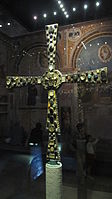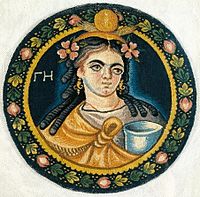- Desiderius cross (enlarge the image to see the medallion in the centre of the lower part of the cross)
- Greek inscription, ΒΟΥΝΝΕΡΙ ΚΕΡΑΜΙ
- The middle figure, mantle knotted on her breast
- The right figure, with a hair style peculiar to Egypt
Corpus
| Portrait | Location | Date | Size | Inscription |
|---|---|---|---|---|
 | Museo di Santa Giulia, Brescia, Italy [1] Traditionally, but wrongly, identified as Galla Placidia with Valentinian III and Honoria. See section below for full account. | 3rd or 4th century [1] | 6 cm (2.4 in) in diameter [2] | Greek: ΒΟΥΝΝΕΡΙ ΚΕΡΑΜΙ [3] (bounneri kerami, meaning uncertain; maybe "Bunneri the potter," using an Egyptian Greek form of κεραμεύς, kerameus) [2] |
 | Metropolitan Museum of Art, New York City [4] | 250–300 [4] | 4.1 cm (1.6 in) in diameter [4] | Greek: ΓΕΝΝΑΔΙ ΧΡѠΜΑΤΙ ΠΑΜΜΟΥϹΙ [5] (Gennadi chrōmati pammousi, "Gennadios, most skilled in music") [6] |
 | Metropolitan Museum of Art, New York City [7] | early 4th century [7] | 4.8 cm (1.9 in) in diameter [7] | no inscription |
 | Corning Museum of Glass, Corning, New York [8] | 3rd century [8] | 4.9 cm (1.9 in) in diameter [8] | Latin: ANATOLI GAVDIAS ("Anatolius, rejoice!") [8] |
 | Victoria and Albert Museum, London [9] | 3rd or 4th century [9] | 4.4 cm (1.7 in) in diameter [9] | no inscription |
 | British Museum, London [10] | ? | 5.1 cm (2.0 in) in diameter [10] | no inscription |
 | Archeological Museum, Bologna, Italy [11] | 1st quarter of 4th century [11] | 5.1 cm (2.0 in) in diameter [12] | Latin transcription of Greek: PIE ZESES [11] [12] ("Drink and you will live") [11] |
 | Archeological Museum, Bologna, Italy [13] | 1st quarter of 4th century [13] | 4.5 cm (1.8 in) in diameter [14] | no inscription |
 | Archeological Museum, Bologna, Italy [15] | 4th century [16] | 3.5 cm (1.4 in) in diameter [15] | Latin: M. COCCEIUS ONESIMUS (probably, the name of the boy) [15] |
 | Archeological Museum, Arezzo, Italy [17] | 200–250 [17] | 4.4 cm (1.7 in) in diameter [17] | no inscription |
 | Museo Sacro, Vatican Library [18] | first half of the 3rd century [18] | 4.9 cm (1.9 in) in diameter [18] | Latin: GRECO RIBIBETPROPINATVIS (perhaps Gregori bibe et propina tuis, [19] "Gregory, drink and drink to thine") [18] |
 | Vatican Library [20] | ? | ? | no inscription |
 | Museo Sacro, Vatican Library [9] | 3rd century [21] | 4.8 cm (1.9 in) in diameter [22] | Latin: EUSEBI ANIMA DULCIS, "To sweet-souled Eusebius" [9] (?) |
 | Vatican Museums [23] | 3rd or 4th century [24] | ? | Latin: GREGORI SIMPLICI CONRECESCATES [23] (perhaps a misspelling of congregatus, so "Gregorius [and] Simplicius together") |
 | Catacomb of San Panfilo, Rome [25] | 4th century or earlier [25] | ? | no inscription |
 | Museo Civico, Turin, Italy [26] | mid-3rd century [26] | 4.5 cm (1.8 in) in diameter [26] | no inscription |
 | Museo Civico, Turin, Italy [27] | 3rd century [27] | ? | no inscription |
 | Vatican Museums [28] | 17th-century copy of a lost original [28] | ? | Latin: [partly illegible] CE PIE ZESES [28] [29] [30] (Romanisation of Greek: "Drink [and] you will live") [11] |










